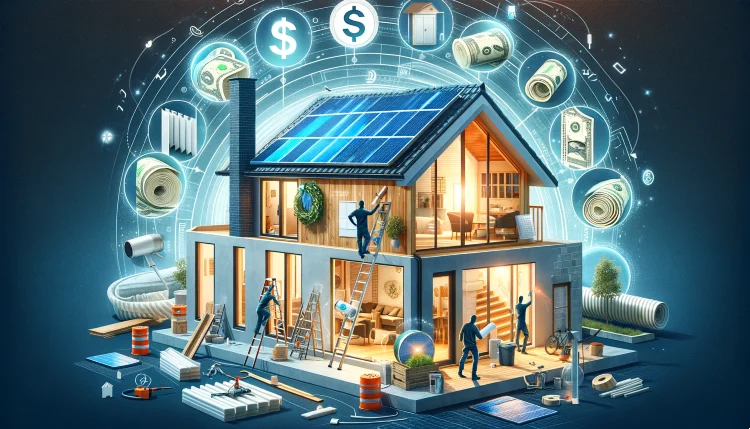The Inflation Reduction Act of 2022 offers a wealth of incentives for homeowners looking to enhance their home’s energy efficiency. This act, a significant legislative step in the U.S., aims to revolutionize how Americans upgrade their homes by making them more energy-efficient, healthier, and environmentally friendly.
At the core of this act are the 25C tax incentives (boring name but great concept), offering substantial tax credits for home energy upgrades.
These credits, which used to only be $500 for a lifetime, were increased up to $3,200. Over three grand is surely a robust enough incentive for most homeowners to undertake more extensive energy-saving measures.
Additionally, the act introduces rebate programs totaling $8.8 billion, distributed across states to assist homeowners in upgrading key home components such as heat pumps and electric wiring. This rebate system is particularly beneficial for those with fixed or low incomes, as it reduces the financial burden of opting for more efficient, technologically advanced, and climate-friendly options.
That’s right, you can help the planet, lower your monthly expenses, and impress your neighbors without spending a small fortune because the government is going to kick in on the costs.
The rebates can be substantial, with amounts up to $8,000 for a heat pump (worth it!) or $840 for an electric stove. These rebates are designed to encourage homeowners to choose more environmentally friendly options and are offered at the point of sale, making them easily accessible.
However, the availability and specifics of these rebates can vary by state. Homeowners interested in these incentives should consult the Department of Energy’s home energy rebates website and their state energy offices. You should also be aware that while some states have already put their plans in place and applied for the rebate program, others are still in the process of doing so.
The Inflation Reduction Act’s incentives are a game-changer for homeowners. They not only offer financial benefits but also contribute to a larger goal of reducing energy consumption and promoting a more sustainable and environmentally friendly lifestyle.
This act represents a big opportunity for homeowners to invest in their homes’ future while contributing positively to broader environmental goals, while saving money!
Frequently Asked Questions: Inflation Reduction Act Home Energy Efficiency Incentives
What is the Inflation Reduction Act?
The Inflation Reduction Act, signed into law in August 2022, allocates $391 billion towards energy and climate change initiatives, including about $35 billion in clean energy investments managed through the Department of Energy.
What home energy rebates does the Act provide?
It includes two provisions totaling $8.8 billion in rebates for home energy efficiency and electrification projects: Home Efficiency Rebates and Home Electrification and Appliance Rebates.
How are these rebates funded?
The Act authorizes $4.3 billion for Home Efficiency Rebates and $4.275 billion for Home Electrification and Appliance Rebates, plus $225 million for Indian Tribes to implement Home Electrification and Appliance Rebates.
When will these rebates be available?
States and Indian Tribes are currently able to apply for these funds. The exact timing of rebate availability will vary, but most households can expect access by 2024.
Can I access rebates for urgent home energy upgrades now?
No, current rebates aren’t accessible yet. However, other federal, state, local, and utility programs, including tax credits and the Weatherization Assistance Program, may offer immediate assistance.
How can I prepare for these rebates?
Consider getting a home energy assessment to identify suitable upgrades. Check existing programs and tax credits if you need financial assistance before rebates become available.
Can I combine these rebates with other incentives?
Yes, stacking Home Energy Rebates with non-federal funds is allowed, provided the total rebate value does not exceed the project cost.
Do I pay upfront for rebates?
For the Home Electrification and Appliance Rebates, rebates are provided at the point of sale. For the Home Efficiency Rebates, states may offer upfront discounts.
Can I participate in both rebate programs?
Yes, if you meet all income requirements for both programs and comply with Federal and State requirements.
What is an aggregator in this context?
An aggregator is an entity coordinating projects for multiple homes or buildings to streamline rebate access.
What technologies are eligible for rebates?
Eligible technologies vary by state but generally include ENERGY STAR-certified appliances like heat pumps, electric stoves, and insulation.
Can solar panels receive these rebates?
No, solar PV installations aren’t eligible for these specific rebates, but may qualify for other federal incentives.
Are rebates available retroactively?
Rebates for Home Efficiency can be retroactive to projects begun after Aug. 16, 2022, but not for Home Electrification and Appliance Rebates.
More To Discover
- Trillion Dollar Lies: What Happened in 2018 That Transformed Renewable Energy Forever
- There Are Trillions of Tons of Clean Power Beneath U.S. Soil
- US Heat Pump Manufacturers Triumph in Cold Climate Challenge, Promising Eco-Friendly Home Heating
- 10 Easy Ways You Can Improve Your Health and the Planet at The Same Time
How long will rebate processing take?
The DOE encourages states to design programs providing immediate discounts at the point of purchase.
For more information and specific details, homeowners should consult the Department of Energy’s website and their state energy offices.



















